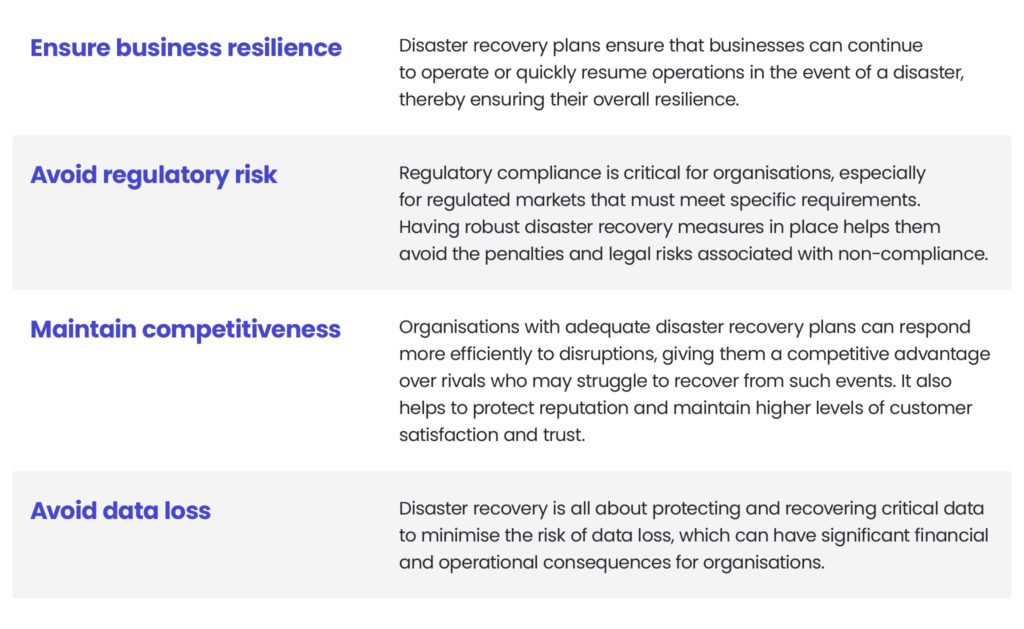Disaster Recovery: strategies for smooth operations
As more businesses go digital and use technology for both operations and revenue generation, the question of “what happens if the technology fails” arises. It is this concern that drives disaster recovery considerations that help organisations prepare a plan in case of a failure.
Globally, the popularity of disaster recovery strategies is on the rise. According to a recent report by the International Data Corporation, companies spent $219 billion last year on cybersecurity, an increase of 12% by 2022.
The role and importance of disaster recovery
Disaster Recovery (DR) refers to the processes and procedures designed to ensure the rapid recovery of IT systems, data, and infrastructure following a catastrophic event such as natural disasters, cyber-attacks, power outages, equipment, or data centre failures. In disaster recovery planning, any event that significantly disrupts normal business operations and threatens data integrity and availability is considered a disaster.
The primary role of disaster recovery is to minimise downtime, data loss and business interruption when a disaster occurs, enabling organisations to resume normal operations quickly. The importance of disaster recovery cannot be overstated, especially in today’s digital age, where organisations rely heavily on technology and data to run their business. With a robust disaster recovery plan in place, organisations can avoid several negative consequences.
What is disaster recovery used for?

Why organisations should have a DR strategy
Stronger business continuity: A well-planned disaster recovery strategy ensures that essential business functions can continue or resume promptly after a disruptive event. This minimises downtime, maintains customer satisfaction, and preserves revenue streams.
Increased security: Disaster recovery planning often involves implementing robust security measures to protect critical data and systems. Addressing potential vulnerabilities and implementing proactive security measures can minimise the risk of data breaches and cyber-attacks.
Faster recovery: With a disaster recovery plan in place, organisations can respond swiftly to disruptions and recover critical systems and data more rapidly. This reduces the overall impact of the disaster and helps the business return to normal operations as quickly as possible.
Reduced recovery costs: While investing in disaster recovery planning and infrastructure has an upfront cost, the long-term benefits often outweigh the expense. Organisations can avoid the significant financial losses associated with prolonged outages or data breaches by minimising downtime or data loss.
High availability: A robust disaster recovery strategy ensures the high availability of critical systems and services, even when unexpected events occur. This reliability is essential for maintaining customer confidence, meeting service level agreements (SLAs) and maintaining business operations in challenging circumstances.
Maintained compliance: Many industries are subject to data protection and business continuity regulations. Implementing a comprehensive disaster recovery strategy helps organisations comply with these regulations and avoid potential fines, penalties and reputational damage.
How do we help our customers design and implement disaster recovery strategies
Over the years, we have developed a framework to help our customers build their DR strategies. We start by collaborating closely with our clients to understand their unique needs and priorities. Through comprehensive assessments, we pinpoint critical systems and data essential for their business continuity. Together, we create a customised DR strategy that aligns with their objectives. Once the strategy is defined, we build infrastructure tailored to their requirements. This includes implementing advanced tools for routine backups and continuous monitoring, ensuring data integrity and system reliability. We prioritise transparency and communication throughout the process, keeping our clients informed at every step, and work hand in hand to establish hardware and network redundancy measures, minimising the risk of downtime and maximising resilience.
Testing is a crucial component of our approach, so we rigorously test recovery protocols in simulated real-world scenarios to validate their effectiveness. This iterative process allows us to refine and improve the DR strategy continuously.
Documentation is key to providing complete guidance and ensuring future readiness. We document every aspect of the strategy and implementation process, empowering our clients with valuable insights for ongoing optimisation and refinement of their DR capabilities.
When developing a disaster recovery strategy, we carefully consider the following client-defined key metrics and commit to delivering:

Spyrosoft’s proven disaster recovery strategies
Our approach to disaster recovery management is finely tuned to each customer’s unique needs and preferences. We understand that different applications have different levels of criticality and, therefore, require tailored resilience strategies.
We prioritise establishing robust backup and recovery protocols for non-critical applications. This involves implementing regular backup routines and rehearsing recovery procedures to quickly restore applications and data in the event of an incident. We aim to minimise downtime and efficiently restore normal operations.
When it comes to critical applications, we employ redundancy measures to ensure uninterrupted availability and minimal disruption. This entails deploying redundant infrastructure such as mirrored servers or failover clusters. These systems seamlessly take over in case of hardware or software failures, maintaining continuous service delivery.
For clients using cloud services or Kubernetes, we leverage these platforms’ inherent flexibility and scalability to strengthen disaster recovery capabilities. It includes implementing automated failover mechanisms and leveraging native cloud capabilities for data replication and synchronisation to ensure data integrity and availability.
In scenarios where maximum uptime is essential, we design and implement two independent application stacks: a hot standby and a cold standby. The hot standby stack remains actively serving traffic, while the cold standby stack is ready to take over seamlessly in case of a primary stack failure. This approach guarantees near-zero downtime and uninterrupted service delivery, even in unforeseen challenges.
When planning for disaster recovery, it’s important to recognise that the scope can extend well beyond the confines of the IT infrastructure. While some organisations include back-up offices and other physical contingencies in their DR strategies, our focus remains primarily on what is happening in data centres.
We are your trusted partner in disaster recovery.
Organisations frequently need to decide whether to stick with traditional disaster recovery solutions or entrust the creation of a disaster recovery plan to a maintenance provider. While on-premises DR offers certain benefits, leveraging the expertise of a trusted technological partner can be game-changing.
Whether you’re looking to enhance your existing disaster recovery capabilities or build a new strategy from scratch, consulting with our experts can provide invaluable insight and guidance. Contact us today by filling out the form below or find out more about our managed services here!
About the author
Contact us




